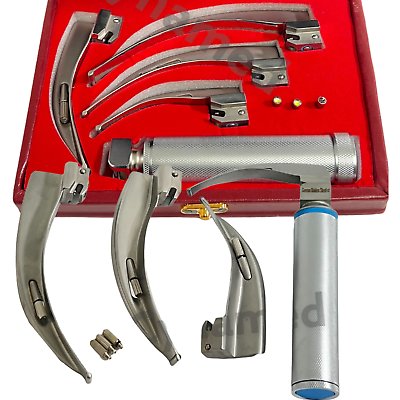Mac and Miller Blades: Essential Tools in Airway Management
Mac and Miller Blades

Introduction
Mac and Miller Blades In the world of airway management, the Macintosh (Mac) blade and the Miller blade are two indispensable tools for laryngoscopy and intubation. These tools have been at the forefront of ensuring patient safety during surgeries, emergency care, and other medical procedures. Understanding their design, function, and the differences between them is crucial for healthcare professionals.
This blog will dive into the features, Mac and Miller Blades applications, advantages, and considerations for choosing between the Mac and Miller blades. Whether you're a seasoned anesthesiologist or a medical student, this comprehensive guide will provide valuable insights into these essential airway management tools.
What Are Mac and Miller Blades?
Both Mac and Miller blades are laryngoscope blades used to visualize the vocal cords and facilitate endotracheal intubation. They are attached to a laryngoscope handle, which provides illumination and ergonomic support.
Macintosh Blade (Mac Blade)
- Invented By: Sir Robert Macintosh in 1941.
- Design: The Mac blade features a curved design, allowing it to displace the tongue and provide a clear view of the glottis indirectly.
- Best For: Adult patients, especially those with normal anatomy, where indirect visualization is sufficient.
Miller Blade
- Invented By: Dr. Robert Miller in 1941.
- Design: The Miller blade is straight, with a narrower tip, allowing it to lift the epiglottis directly for better visibility of the vocal cords.
- Best For: Pediatric patients or adults with challenging airway anatomies.
Key Differences Between Mac and Miller Blades
| Feature | Macintosh Blade | Miller Blade |
|---|---|---|
| Shape | Curved blade | Straight blade |
| Epiglottis Handling | Indirect displacement | Direct lifting |
| Preferred Use | Adults with normal airway anatomy | Pediatrics and difficult airways |
| Visibility | Provides an indirect view of the glottis | Offers direct visualization of the glottis |
| Ease of Use | Easier for beginners | Requires more skill and precision |
Applications of Mac and Miller Blades
Emergency Medicine
In emergency settings, quick and accurate intubation is vital. The choice between a Mac and Miller blade depends on the patient's airway anatomy:
- Mac Blades are often used in adults with straightforward airways.
- Miller Blades are preferred for patients with anomalies or challenging airways.
Anesthesia
During surgeries, anesthesiologists rely on laryngoscopes to secure the airway:
- Mac Blades are widely used in routine intubations.
- Miller Blades are crucial for pediatric patients or cases involving swollen or obstructed airways.
Pediatrics
For neonatal and pediatric patients, the Miller blade is the gold standard due to its ability to directly lift the floppy epiglottis, which is more prominent in younger patients.
Difficult Airway Management
Patients with limited neck mobility, obesity, or unusual anatomical structures may require the Miller blade for precise control and direct visualization.
Training and Simulation
Medical training often incorporates both blades to help students understand their differences and applications.
Advantages of Mac and Miller Blades
Macintosh Blade
- Ease of Use: The curved design makes it easier for beginners to use.
- Gentler on the Epiglottis: The indirect displacement reduces the risk of trauma to the epiglottis.
- Wide Application: Suitable for most adult patients.
Miller Blade
- Direct Visibility: Provides a clear, unobstructed view of the vocal cords.
- Versatility: Can be used in patients with challenging airway anatomies.
- Essential for Pediatrics: Specifically designed to manage the unique anatomy of infants and children.
Challenges and Limitations
Mac Blade
- Not Ideal for All Airway Types: In patients with challenging anatomies, the indirect approach may not provide sufficient visibility.
- Limited Use in Pediatrics: The curved design is less effective in lifting the epiglottis in younger patients.
Miller Blade
- Steeper Learning Curve: Requires more precision and skill to use effectively.
- Risk of Trauma: The straight blade may cause injury if not handled carefully.
- Patient Discomfort: The design can be more uncomfortable, particularly for awake patients.
How to Choose Between Mac and Miller Blades
Patient Age
- For adults, the Mac blade is generally preferred.
- For neonates and children, the Miller blade is more effective.
Airway Anatomy
- In patients with normal airways, the Mac blade provides sufficient visibility.
- For difficult airways, such as those with limited neck mobility or unusual structures, the Miller blade is a better choice.
Practitioner Experience
- Beginners may find the Mac blade easier to use.
- Experienced practitioners often prefer the Miller blade for its precision and versatility.
Clinical Setting
- In emergency or trauma cases, having both blades available ensures flexibility.
Mac and Miller Blade Sizes
Both Mac and Miller blades come in a variety of sizes to accommodate patients of different ages and anatomies. Here is a general size guide:
| Blade Type | Size Range | Application |
|---|---|---|
| Mac Blade | 1 to 5 | Neonates (Size 1) to adults (Size 5) |
| Miller Blade | 0 to 4 | Premature infants (Size 0) to adults (Size 4) |
Tips for Using Mac and Miller Blades
Proper Technique
- For the Mac blade, position the tip in the vallecula (the space between the base of the tongue and the epiglottis).
- For the Miller blade, lift the epiglottis directly to visualize the vocal cords.
Practice and Training
Regular practice with both blades ensures proficiency and confidence in their use.
Handle and Light Source
Ensure the laryngoscope handle is compatible with the blade and the light source is functioning properly.
Patient Safety
Use gentle, controlled movements to minimize the risk of trauma.
Technological Advancements
Recent innovations have enhanced the functionality of both Mac and Miller blades:
- Video Laryngoscopes: These devices combine traditional blade designs with video cameras for better visualization.
- Disposable Blades: Single-use options reduce the risk of cross-contamination.
- LED Lighting: Modern blades feature brighter, more efficient light sources.
Top Suppliers of Mac and Miller Blades
Welch Allyn
Known for high-quality laryngoscope systems with advanced illumination.
Medtronic
Offers a range of Mac and Miller blades designed for optimal performance.
SunMed
Provides both reusable and disposable options for Mac and Miller blades.
Intersurgical
Specializes in lightweight, ergonomic laryngoscope blades.
Ambu
A leader in single-use airway management devices, including disposable Mac and Miller blades.
Conclusion
The Macintosh and Miller blades are essential tools in airway management, each with unique features and advantages. While the Mac blade is ideal for routine intubations in adults, the Miller blade excels in pediatric and challenging airway scenarios. Understanding their differences, applications, and proper use is crucial for healthcare providers.
As medical technology continues to evolve, innovations in laryngoscope blades will further enhance patient care, making procedures safer, faster, and more effective. Whether you're an anesthesiologist, emergency responder, or trainee, mastering the Mac and Miller blades is an indispensable skill for modern medical practice.
FAQs
Can I use a Mac blade for pediatric patients?
While possible, the Miller blade is generally better suited for pediatric cases due to its ability to lift the epiglottis directly.
Are disposable blades as effective as reusable ones?
Yes, disposable Mac and Miller blades are designed to meet the same performance standards while offering enhanced hygiene.
What size blade should I use for a newborn?
For neonates, use a Miller blade size 0 or 1, depending on the patient’s size.
How do I clean reusable blades?
Follow manufacturer guidelines, typically involving disinfection and sterilization.
Should I choose a video laryngoscope?
Video laryngoscopes can enhance visualization and are particularly useful in difficult airway cases.
What's Your Reaction?


















